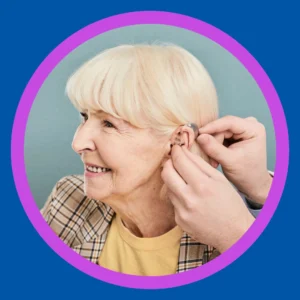The Key to Better Hearing: Understanding Your Hearing Aid Fitting
If you’ve already completed your hearing test or hearing aid evaluation, your next step is the hearing aid fitting. This appointment isn’t just about trying on your new devices. It’s a detailed, customized process that ensures your hearing aids work properly, fit comfortably, and improve your quality of life.
At Stanford Hearing, we believe every hearing aid fitting should be precise, educational, and empowering. A professional in-center fitting gives you the greatest chance for long-term success with your devices.
Let’s walk through what you can expect and why this step is so important.
Why the Hearing Aid Fitting Process Matters
You’ve invested in hearing aids. Now it’s time to make sure they work for you. A hearing aid fitting does far more than match a device to your ear. It ensures the settings match your hearing loss, lifestyle, and comfort preferences.
Without a proper fitting, even the most advanced hearing aids may underperform. Sounds may be too sharp, too soft, or unbalanced. You may feel overwhelmed by noise or still struggle to hear clearly. A good fitting eliminates those challenges by:
- Customizing sound based on your unique hearing profile
- Teaching you how to use, adjust, and care for your devices
- Helping you adjust to hearing the world again
- Building long-term support for future needs
Your hearing care provider at Stanford Hearing will take the time to make sure everything works the way it should, right from the start.
Step 1: Creating Your Hearing Profile
Before your hearing aid fitting appointment, your provider will have already conducted a full hearing assessment. This assessment forms the foundation of your personalized hearing profile.
The tests performed during your hearing exam include:
- Pure-tone audiometry: Measures the softest sounds you can hear across multiple frequencies
- Speech recognition testing: Evaluates how well you can understand spoken words
- Dynamic range testing: Determines your tolerance for loud sounds and helps avoid discomfort
- Additional diagnostic measures: May include tympanometry, masking, or otoscopy to rule out underlying conditions
These results are mapped on an audiogram, which your provider uses to program your hearing aids. The data ensures amplification is targeted exactly where you need it. No two people hear the same way. This profile ensures your fitting is as unique as your hearing.
Understand how undiagnosed age-related hearing loss affects your life.
Step 2: Selecting the Right Hearing Aid Style
Choosing a hearing aid style is a personal and functional decision. It’s not just about how the device looks—it’s about how it works for your lifestyle, preferences, and hearing loss severity.
Your hearing care provider will guide you through the available options, such as:
- Behind-the-Ear (BTE): A powerful, durable choice that rests behind your ear with tubing to an earpiece
- Receiver-in-Canal (RIC): Offers a discreet fit with better sound clarity, placing the speaker directly in your ear canal
- In-the-Ear (ITE): Custom-molded to your outer ear and easy to manage
- In-the-Canal (ITC): Smaller than ITE, partially hidden within the ear canal
- Completely-in-Canal (CIC): Nearly invisible and sits deeply inside the ear canal
- Invisible-in-Canal (IIC): The most discreet option, completely hidden in the canal
Your ear anatomy, dexterity, aesthetic preference, and daily routine will all influence the best style for you. If your choice requires a custom fit, your provider will take ear impressions during or shortly after your evaluation.
Once selected, your devices are ordered and prepped for the fitting.
Find out more about Starkey hearing aid models.
Step 3: How to Prepare for Your Fitting Appointment
Your fitting appointment is your official start to better hearing. Preparing ahead of time helps you get the most from your visit.
Here’s how to prepare:
- Bring a friend or loved one: They can help take notes and ask questions
- List your questions: Write down anything you want to know about features, use, or care
- Set your expectations: Understand that adjusting to hearing aids takes time and patience
- Block enough time: The appointment usually takes 60–120 minutes, depending on your needs
- Think about your lifestyle: Your provider will ask how and where you plan to use your hearing aids most
Preparation helps make your fitting more efficient, more productive, and more personalized.

Step 4: What Happens During Your Hearing Aid Fitting
The fitting itself is hands-on and highly personalized. Your hearing care provider will guide you through each step and explain everything along the way.
Initial Inspection and Setup
When your devices arrive, your provider will:
- Verify your hearing aids match your chosen style and model
- Review your hearing test results and ensure your audiogram is up to date
- Program the devices based on your test data
- Explain all the key parts of the device: microphone, receiver, battery door, etc.
- Teach you how to insert and remove the hearing aids
You’ll also discuss how your hearing aids are designed to support your unique hearing profile.
Real Ear Measurement (REM)
Real Ear Measurement (REM) is one of the most important parts of the fitting. It ensures the amplification settings match your hearing needs in real-world conditions.
Here’s how it works:
- A small probe microphone is gently placed inside your ear canal
- The provider plays calibrated sounds to measure how sound behaves inside your ear
- Your hearing aids are inserted with the probe still in place
- The device’s output is measured again
- Your provider adjusts the settings to ensure sounds reach your eardrum properly
Why is REM important? Because every ear is shaped differently, and hearing aids must be customized to that shape. Fittings done with REM provide better clarity, speech understanding, and user satisfaction.
Fine-Tuning and Sound Testing
With the technical setup complete, your provider will:
- Ask for your feedback about loudness, sharpness, and clarity
- Test your understanding of speech in quiet and noisy environments
- Adjust directional microphones to improve focus on conversations
- Activate any optional features like background noise reduction or music programs
Your comfort matters. You’ll be asked how the devices feel physically and how the sounds make you feel emotionally. Every setting can be adjusted to meet your expectations.
Step 5: Learning to Use Your Hearing Aids
Before you leave, you’ll learn everything you need to start using your hearing aids confidently.
Device Handling
- How to insert and remove them properly
- How to change programs or adjust volume (if applicable)
- How to manage battery use or charging
Maintenance and Care
- How to clean and store your devices
- How to protect them from moisture and wax
- What to do if they whistle, distort, or cut out
Technology and Features
- How to pair them with your smartphone
- How to use mobile apps for volume or environment changes
- How to activate features like Bluetooth, telecoil, or remote microphones
You’ll leave with printed instructions and hands-on practice to reinforce what you’ve learned so that you can enjoy the full benefits your devices provide.
Find out more about ear and hearing care from World Hearing Day.

Step 6: Adapting to Your New Hearing Aids
Getting used to hearing aids takes time. At first, everything may sound too loud, too sharp, or unfamiliar. That’s normal. Your brain is re-learning how to process sound.
You’ll start hearing things you forgot existed: footsteps, paper rustling, birds singing, clocks ticking. These are all signs your devices are working.
To adapt smoothly:
- Wear your hearing aids daily, starting with a few hours and building up
- Note any sounds that feel uncomfortable or unclear
- Follow your provider’s suggested wearing schedule
- Attend all follow-up appointments to make adjustments
Adapting may take a few weeks, but the effort pays off. The more consistently you wear your hearing aids, the faster your brain adapts.
Explore the top hearing aid accessories.
Step 7: What Happens After the Fitting
You won’t be left on your own after your fitting. In fact, this is just the beginning of your support journey.
Your provider will schedule a follow-up within 2–4 weeks. At that visit, you’ll:
- Share feedback about comfort and clarity
- Report challenges in specific environments
- Ask questions about features or troubleshooting
- Receive further adjustments for better performance
Your hearing needs may evolve. Regular check-ins help keep your devices working their best. Some people return seasonally or yearly for reassessment and retuning.
Why In-Center Hearing Aid Fittings Work Best
In-person fittings give you the full benefit of your devices. Self-fitting or over-the-counter hearing aids can’t match the customization of a professional fitting.
Benefits of in-center fittings include:
- Real Ear Measurement for personalized sound delivery
- Accurate adjustments for lifestyle needs
- Ongoing coaching and follow-up support
- Long-term success with fewer frustrations
When you work with a hearing care provider in person, you get more than devices. You get expert support for your hearing health journey.

Final Thoughts: The Value of a Proper Hearing Aid Fitting
A hearing aid fitting is not just a technical process—it’s a key part of better hearing. It ensures your devices work for you, support your lifestyle, and help you feel confident again in social and professional situations.
At Stanford Hearing, we take the time to understand your hearing needs, preferences, and goals. We guide you through each step, from testing to fitting to follow-up care.
If you’re ready to start hearing better and living fully, we’re here to help.
Contact Stanford Hearing today to schedule your personalized hearing aid fitting. Let’s make better hearing your new normal.
